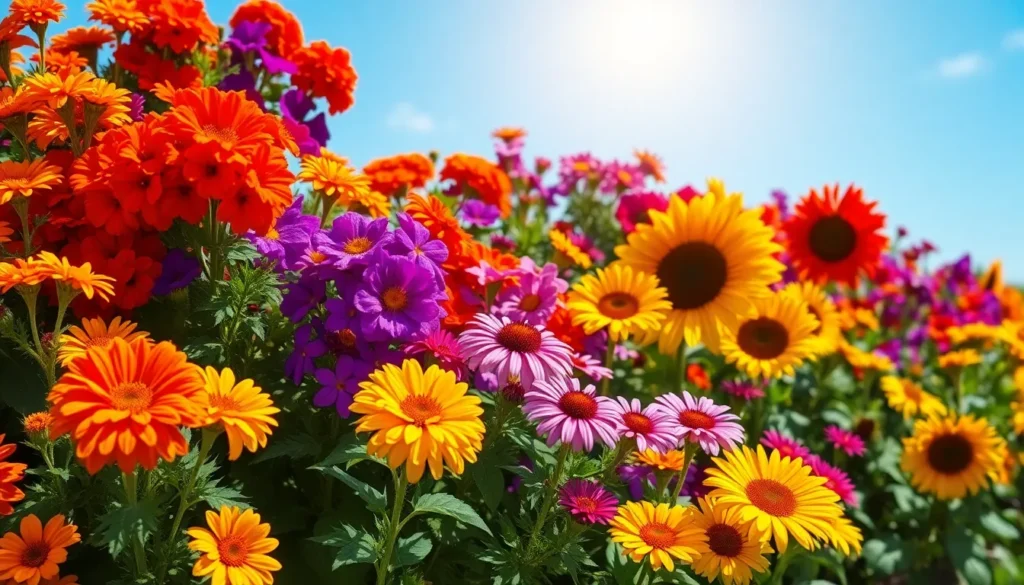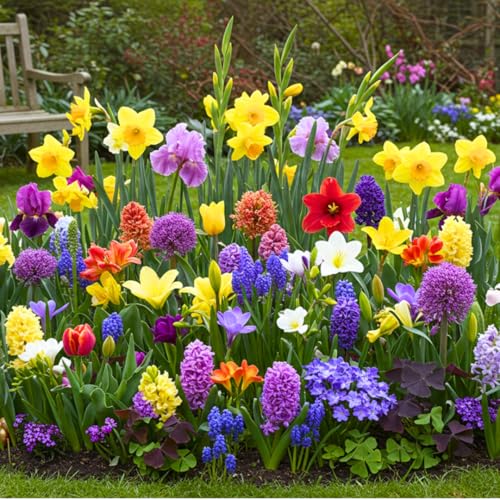We all dream of gardens bursting with vibrant colors from spring’s first warm days until autumn’s final frost. Annual flowers that bloom all summer make this dream a reality without the guesswork of perennial timing or the disappointment of short-lived blooms.
These powerhouse plants work tirelessly to transform ordinary spaces into spectacular displays of continuous color. Unlike their perennial cousins that offer brief moments of glory, summer-long annuals keep producing fresh flowers week after week. They’re perfect for busy gardeners who want maximum impact with minimal fuss.
Whether you’re filling containers on a sunny patio or creating bold borders in your industry, the right selection of long-blooming annuals ensures your garden stays picture-perfect all season long. We’ll explore the best varieties that deliver non-stop blooms and share expert tips for keeping them flowering from May through September.
Marigolds: The Vibrant Workhorses of Summer Gardens
Marigolds stand as the ultimate summer champions, delivering continuous blooms from late spring through the first frost. These dependable annuals require minimal care while producing an abundance of vibrant flowers that brighten any garden space.
French Marigolds for Compact Color
French marigolds offer perfect proportions for containers and border edges with their compact 6-8 inch height. These petite powerhouses produce dozens of small, densely packed blooms in shades of yellow, orange, red, and burgundy throughout the entire growing season.
We recommend planting French marigolds in window boxes, hanging baskets, or as edging plants along pathways where their neat, bushy growth habit creates defined lines. Popular varieties like ‘Bonanza’ and ‘Hero’ series deliver exceptional performance with their weather-resistant blooms that bounce back quickly after heavy rains.
Their quick germination time of 5-7 days makes French marigolds ideal for succession planting every 2-3 weeks. This technique ensures continuous color even if some plants become stressed during peak summer heat. The flowers also attract beneficial insects like ladybugs and hoverflies while deterring harmful pests such as aphids and whiteflies.
African Marigolds for Bold Statement Blooms
African marigolds command attention with their impressive 10-14 inch height and massive 3-4 inch diameter flowers. These giants produce fewer but significantly larger blooms in brilliant shades of gold, orange, and cream that serve as stunning focal points in garden beds.
We plant African marigolds as centerpieces in large containers or as background plants in mixed borders where their substantial presence anchors the design. Varieties like ‘Antigua’ and ‘Perfection’ series offer exceptional flower size and strong stems that resist wind damage.
Their deep root systems make African marigolds excellent choices for hot, dry locations where other annuals struggle. These heat-loving plants actually perform better in temperatures above 75°F and continue blooming prolifically even during drought conditions. The larger flowers also make excellent cut flowers, lasting 5-7 days in vases when stems are cut early in the morning.
Petunias: Cascading Beauty From Spring to Frost
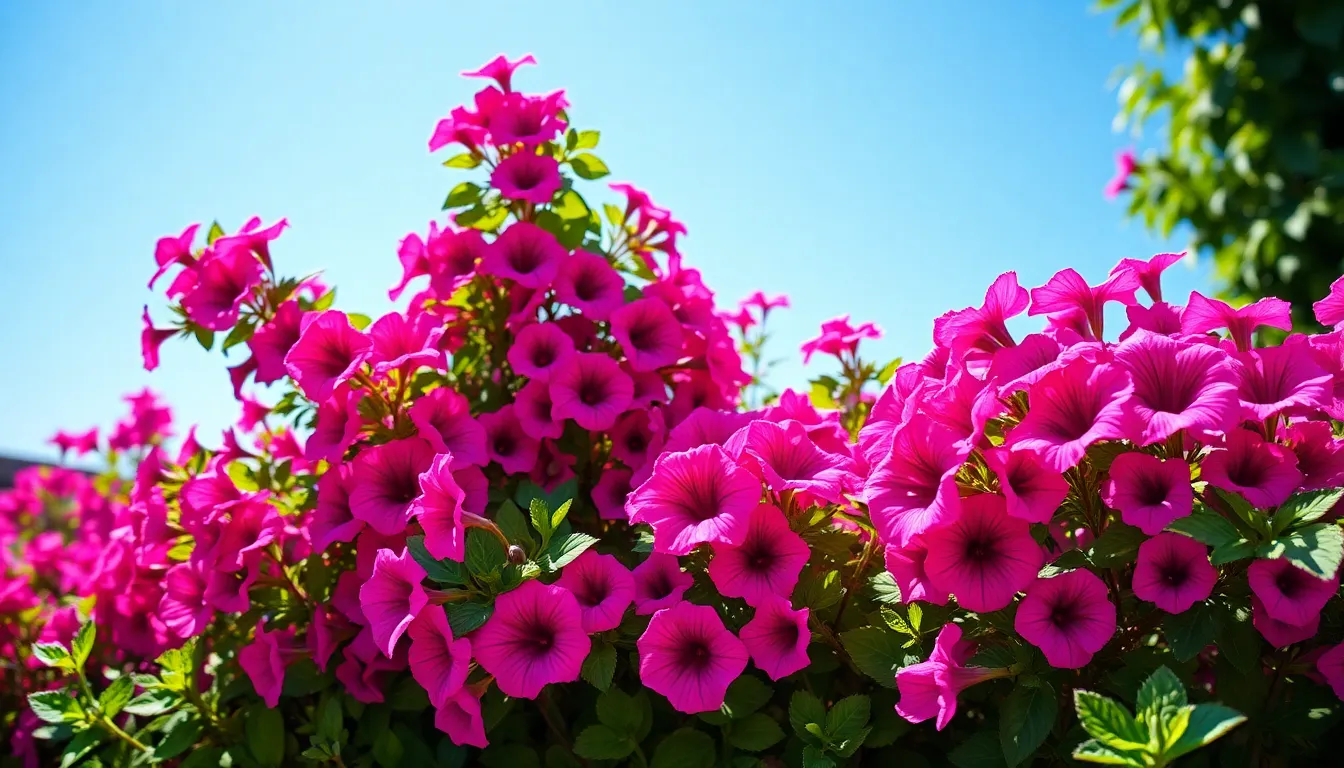
Petunias offer unmatched versatility for summer gardens with their continuous blooming habit and stunning cascading flowers. These reliable annuals deliver vibrant color displays in hanging baskets and containers from spring until the first frost hits.
Wave Petunias for Ground Cover
Wave petunias transform into spectacular ground cover that spreads quickly across garden beds and borders. These vigorous plants create colorful carpets that bloom continuously throughout the summer season without requiring frequent deadheading.
Spreading Power: Wave varieties can spread up to 4 feet wide while maintaining their compact 6-inch height. Gardens benefit from this rapid expansion as plants fill bare spots and create stunning visual impact.
Color Variety: Pink, purple, red, and white wave petunias offer endless design possibilities for industry schemes. Mixed plantings create ever-changing color combinations that complement existing garden elements.
Low Maintenance: These hardy performers tolerate heat and drought conditions better than traditional petunias. Gardeners appreciate their self-cleaning nature and reduced need for constant watering.
Grandiflora Petunias for Large Showy Flowers
Grandiflora petunias produce the largest flowers in the petunia family with blooms reaching 4 to 5 inches across. These dramatic specimens serve as stunning focal points in containers and formal garden arrangements.
Flower Size: Individual grandiflora blooms can measure up to 5 inches in diameter with ruffled or smooth edges. Container gardens showcase these impressive flowers beautifully when planted as centerpiece specimens.
Color Range: Deep purples, bright pinks, pure whites, and bicolor combinations provide endless design options. Gardeners can select from solid colors or striking patterns with contrasting veins and edges.
Best Uses: Hanging baskets and large decorative containers highlight grandiflora petunias most effectively. These plants require more protection from wind and rain due to their delicate, oversized blooms.
Zinnias: Heat-Loving Blooms in Every Color
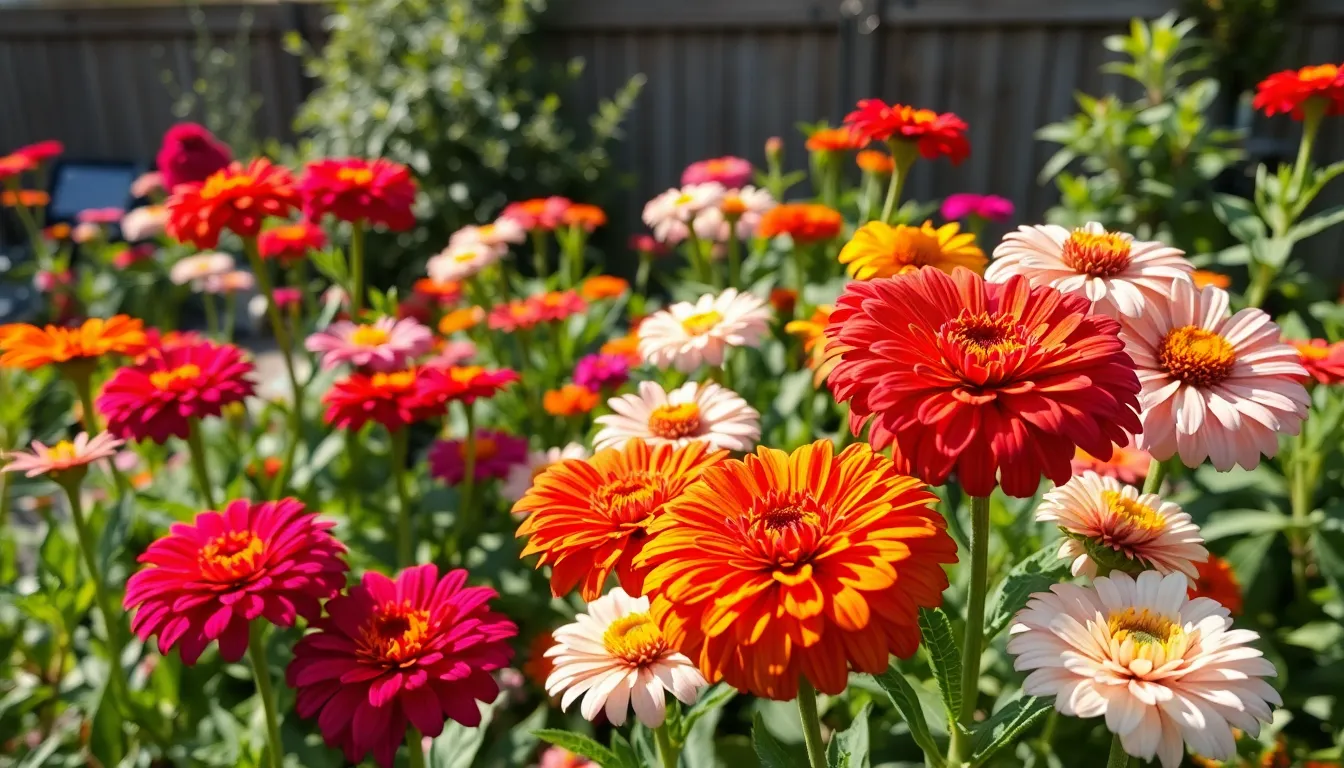
Zinnias excel as summer garden champions, thriving in warm weather while delivering continuous color from early summer through the first frost. These versatile annuals offer gardeners an extensive palette of vibrant hues and flower sizes to suit any industry design.
State Fair Mix for Giant Blooms
State Fair Mix zinnias produce spectacular giant blooms that can reach up to 5 inches across, creating dramatic focal points in large garden spaces. These tall varieties typically grow 3 to 4 feet in height, making them perfect for back borders or cutting gardens where their impressive size won’t overwhelm smaller plants.
We recommend planting State Fair Mix zinnias in areas with full sun exposure and well-draining soil to maximize their blooming potential. Space them approximately 12 to 18 inches apart to allow proper air circulation and prevent fungal issues. Their substantial flower heads come in rich colors including deep reds, bright oranges, sunny yellows, and pure whites.
Deadheading spent blooms regularly encourages continuous flower production throughout the summer months. Cut stems back to the next set of leaves or buds to promote bushier growth and more abundant flowering. These giants work exceptionally well as cut flowers, often lasting 7 to 10 days in vases when properly conditioned.
Profusion Series for Compact Gardens
Profusion Series zinnias deliver abundant blooms in a compact package, typically reaching only 8 to 12 inches in height and width. These disease-resistant varieties excel in containers, window boxes, and front border plantings where space is limited but maximum color impact is desired.
We’ve found that Profusion zinnias outperform many other compact annuals in hot, humid climates due to their exceptional heat tolerance and powdery mildew resistance. Their dense, mounded growth habit creates a carpet of color that requires minimal maintenance once established.
Plant Profusion Series zinnias 6 to 8 inches apart for quick coverage and continuous blooming from late spring through fall. These self-cleaning varieties rarely need deadheading, making them ideal for busy gardeners who want beautiful results with minimal effort. Available colors include cherry, fire, orange, white, and yellow, allowing for creative color combinations in mixed plantings.
Impatiens: Shade-Tolerant Continuous Bloomers
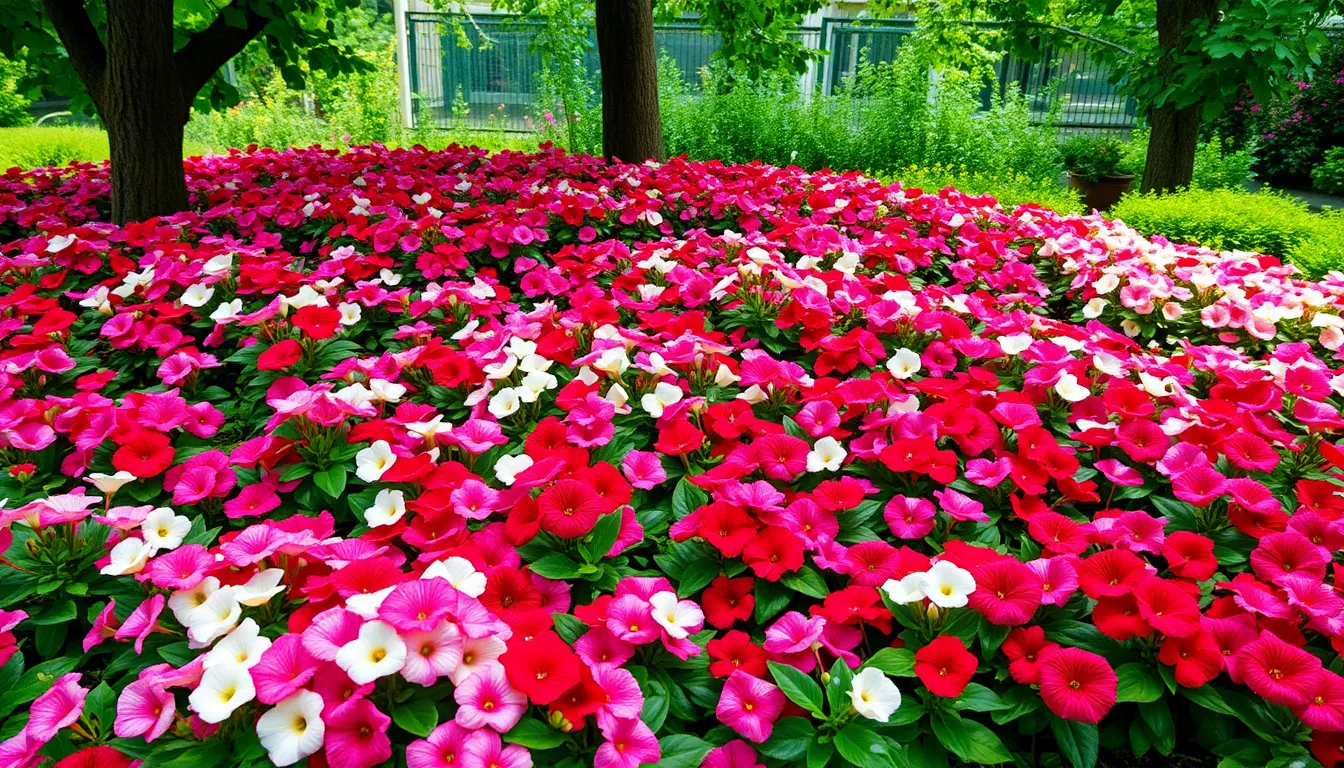
Impatiens offer gardeners reliable summer color in challenging low light conditions where many annuals struggle to perform. We’ve found these versatile flowers excel in areas that receive limited sunlight throughout the day.
New Guinea Impatiens for Sun Tolerance
New Guinea impatiens provide more flexibility when we’re working with varied lighting conditions in our gardens. These robust plants tolerate sunlight better than their standard counterparts, making them perfect for spots that receive morning sun or filtered afternoon light. We recommend planting them in areas that get 4-6 hours of indirect sunlight daily for optimal performance.
Varieties like ‘SunPatiens’ and ‘Divine’ series thrive in conditions that would stress traditional impatiens. Colors range from vibrant orange and pink to deep burgundy and white, giving us plenty of options for our summer displays. We’ve noticed these plants maintain their blooms consistently from late spring through the first frost without requiring deadheading.
Their larger leaves and sturdier stems make New Guinea impatiens excellent choices for containers and mixed plantings. We often pair them with coleus or caladiums to create stunning shade combinations that last all season long.
Standard Impatiens for Deep Shade Areas
Standard impatiens excel in deep shade locations where few other flowering annuals will bloom successfully. We rely on these dependable performers for adding color to north facing borders, under large trees, and in covered patio areas. These plants actually prefer shade and will struggle if exposed to direct sunlight for extended periods.
Busy Lizzie varieties produce masses of small flowers in white, pink, red, purple, and salmon tones. We’ve found they create dense carpets of color when planted 8-10 inches apart in garden beds. Their succulent stems and delicate flowers require consistent moisture but reward us with non stop blooms throughout summer.
Double flowered varieties like ‘Fiesta’ series offer rose like blooms that add texture to our shade gardens. We use these premium selections in prominent containers and hanging baskets where their fuller flowers create maximum visual impact. Standard impatiens self clean, eliminating the need for regular maintenance while delivering continuous color from spring planting until autumn frost.
Begonias: Versatile Flowers for Any Garden Spot
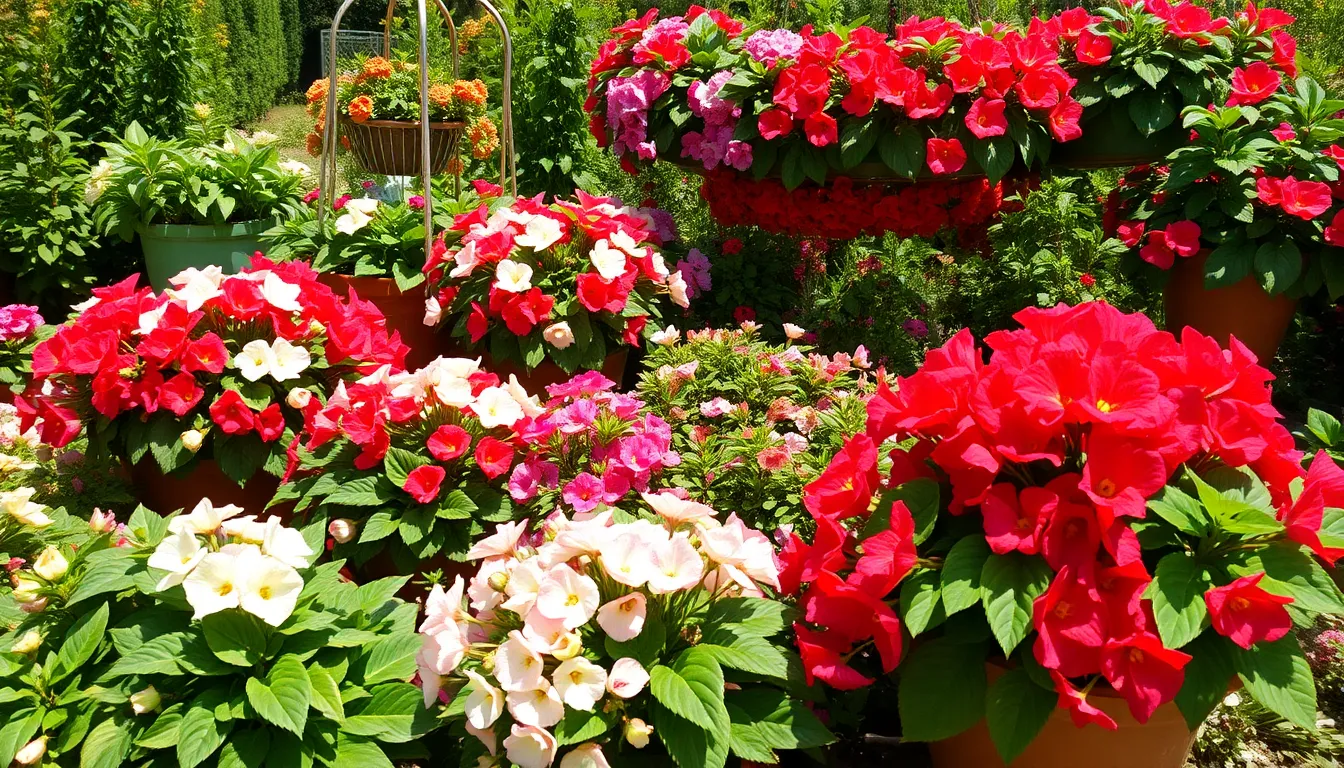
Begonias offer exceptional versatility for summer gardens, thriving in partial shade conditions where other annuals might struggle. These reliable bloomers deliver continuous color from spring through autumn with minimal maintenance requirements.
Wax Begonias for Easy Care
Wax begonias provide effortless gardening success for both beginners and experienced gardeners seeking low maintenance options. These compact plants produce masses of small, waxy flowers in shades of white, pink, red, and coral throughout the growing season. Watering requirements remain minimal once established, making them perfect for busy gardeners who can’t tend to their plants daily.
Container gardening becomes simple with wax begonias since they adapt well to various pot sizes and hanging basket arrangements. Their bronze or green foliage creates attractive contrast against the vibrant blooms, adding depth to garden designs. Heat tolerance allows these flowers to maintain their appearance even during summer’s hottest days when other annuals might wilt.
Spacing wax begonias 6 to 8 inches apart ensures proper air circulation while creating full coverage in garden beds. These self cleaning flowers drop spent blooms naturally, eliminating the need for deadheading maintenance. Fertilizing monthly with balanced plant food keeps the blooms coming consistently until the first frost arrives.
Dragon Wing Begonias for Large Displays
Dragon Wing begonias create stunning focal points with their cascading growth habit and large, wing shaped leaves. These vigorous growers can reach 12 to 15 inches in height and spread up to 18 inches wide, making them ideal for filling large containers or covering substantial garden areas. Bright red or pink flowers dangle gracefully from sturdy stems, creating dramatic visual impact in industry designs.
Hanging baskets showcase Dragon Wing begonias beautifully since their trailing nature allows blooms to spill over container edges. Garden beds benefit from their full, bushy growth that fills spaces quickly without requiring multiple plants. These varieties handle morning sun better than standard begonias, tolerating 4 to 6 hours of direct sunlight when provided with afternoon shade.
Propagation proves simple with Dragon Wing begonias since they root easily from stem cuttings taken in late summer. Overwintering becomes possible by bringing containers indoors before the first frost, allowing you to enjoy these beautiful plants year after year. Their impressive size and continuous blooming make them excellent investments for gardeners wanting maximum impact from their annual flower selections.
Celosia: Unique Textured Blooms All Season Long
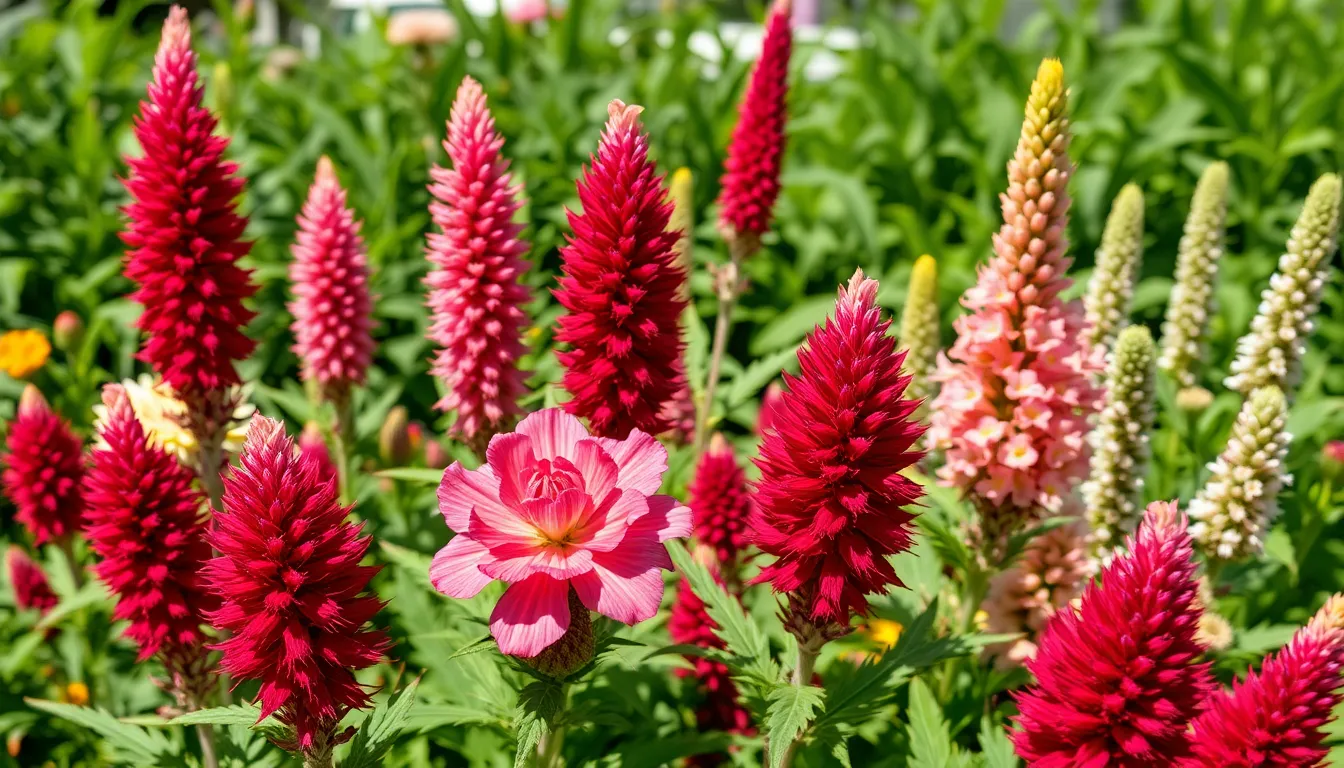
Celosia stands out among summer annuals with its distinctive textures and sculptural qualities that create striking focal points in any garden design. This heat-loving annual delivers continuous color from early summer through the first frost, making it an excellent complement to the other reliable bloomers we’ve explored.
Cockscomb Celosia for Bold Statement Pieces
Cockscomb celosia creates dramatic garden displays with its brain-like, crested blooms that demand attention in any industry setting. These sculptural flowers add architectural interest to borders and containers while maintaining their vibrant colors throughout the hottest summer months.
Color variety spans from soft pastels like white, pale lemon, and peach to rich, deep tones including burgundy and crimson. We recommend using the pastel varieties for elegant, sophisticated displays and the deeper colors for creating bold contrasts against green foliage.
Garden placement works best when you position cockscomb celosia as centerpiece plants in mixed borders or as standalone specimens in containers. Their unique texture creates visual interest even when planted alongside simpler flowers like the marigolds and petunias we’ve discussed.
Growing requirements include full sun exposure and well-draining soil, similar to zinnias in their preference for warm, dry conditions. Plant them 12-15 inches apart to allow proper air circulation and prevent fungal issues that can affect their distinctive crested blooms.
Plume Celosia for Feathery Garden Texture
Plume celosia offers soft, feathery spikes that create gentle movement in summer gardens while providing the same reliable blooming performance as their cockscomb cousins. These delicate-looking flowers actually prove remarkably durable in heat and drought conditions.
Texture benefits include adding vertical interest to low-growing plantings and creating natural transitions between different garden sections. The feathery plumes work particularly well when combined with the rounded forms of begonias or the spreading habits of petunias we’ve covered.
Color selection encompasses vibrant options including red, magenta, orange, pink, gold, and yellow, giving you flexibility to match existing garden schemes. We suggest using warm colors like red and orange for energetic displays or cooler pink and yellow tones for more subtle arrangements.
Practical advantages extend beyond their beauty, as plume celosia flowers retain their shape and color when dried, making them valuable for both fresh arrangements and long-lasting create projects. This dual purpose adds extra value compared to many other summer annuals that only serve ornamental functions in the garden.
Maintenance requirements remain minimal once established, requiring only occasional watering during extreme heat and no deadheading since the plants self-clean like impatiens. Space them 8-10 inches apart for optimal growth and air circulation.
Sunflowers: Cheerful Giants That Bloom Until Fall
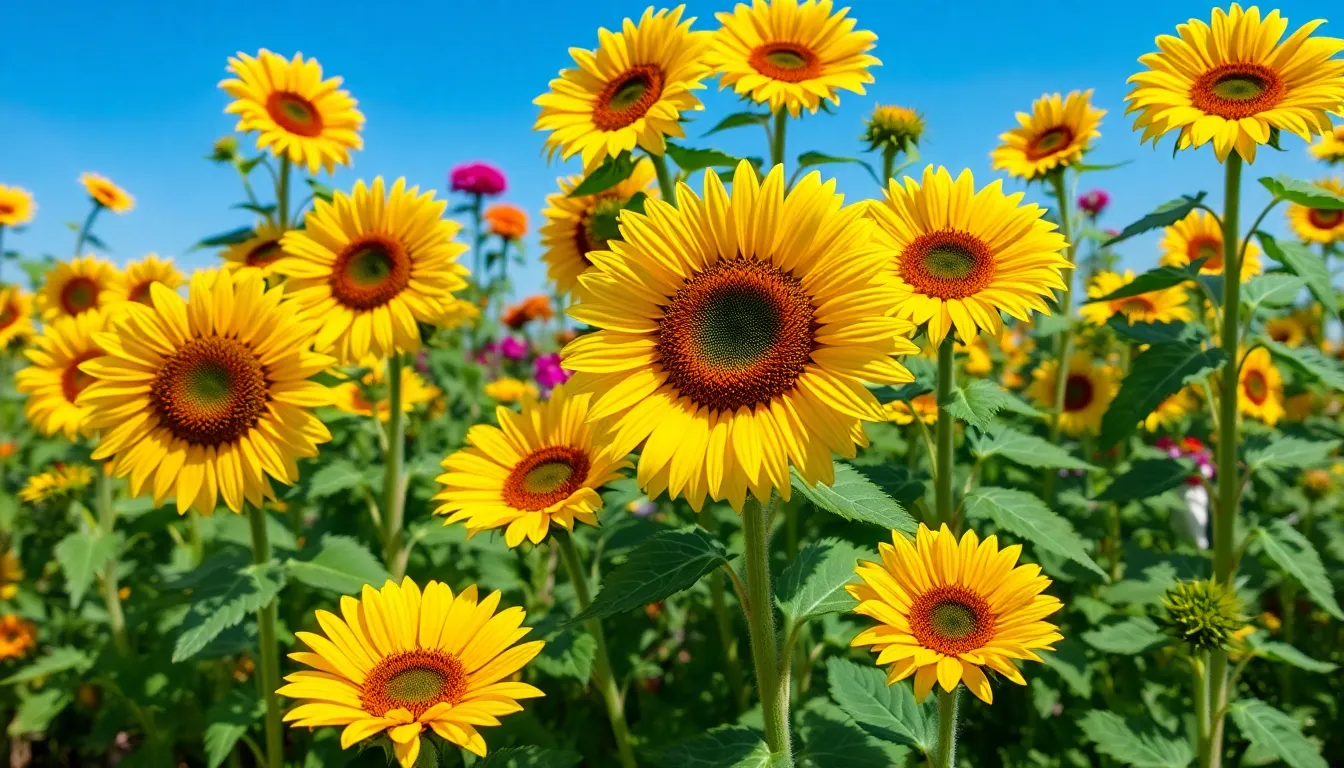
While many gardeners associate sunflowers with towering single stems, these versatile annuals offer remarkable diversity for continuous summer color. Modern breeding has produced compact varieties perfect for containers and multi-branching types ideal for cutting gardens.
Dwarf Sunflower Varieties for Small Spaces
Teddy Bear sunflowers transform small garden spaces with their fluffy, double blooms reaching just 2-3 feet tall. These compact beauties produce 6-inch golden flowers that resemble pom-poms rather than traditional sunflower faces. We recommend planting them 12 inches apart in containers or front borders where their cheerful presence brightens any space from midsummer through fall.
Sunspot dwarf sunflowers deliver classic sunflower appeal in a 2-foot package. Each plant produces one large 10-inch bloom with the traditional yellow petals and dark center that attracts beneficial pollinators. Container gardeners particularly appreciate these varieties since they don’t require staking and fit perfectly in pots 12 inches or larger.
Pacino series sunflowers offer incredible diversity in small spaces with their 12-16 inch height and 4-6 inch blooms. Available in gold, lemon, and red varieties, these petite performers bloom continuously from early summer until frost. Succession planting every two weeks ensures we maintain constant color throughout the growing season.
Branching Sunflowers for Cut Flower Gardens
ProCut series sunflowers revolutionize cut flower production with their branching habit and uniform stem lengths. Each plant produces 15-20 stems measuring 24-30 inches, perfect for bouquet arrangements. We’ve found varieties like ‘ProCut Red’ and ‘ProCut Gold’ deliver exceptional vase life lasting 7-10 days when properly conditioned.
Sunrich series sunflowers provide commercial quality blooms for home gardeners seeking abundant cut flowers. These 4-6 foot plants produce multiple stems with 4-6 inch pollen-free blooms in colors ranging from golden yellow to deep red. Pollen-free varieties prevent staining tablecloths and clothing, making them ideal for indoor arrangements.
Mammoth Grey Stripe sunflowers combine impressive height with multiple branching for both visual impact and cutting potential. Reaching 8-12 feet tall, these giants produce one large central bloom followed by many smaller side branches perfect for harvesting. We recommend planting them along back borders where their dramatic presence creates stunning backdrops while providing weeks of cutting material.
Cosmos: Delicate Blooms With Impressive Staying Power
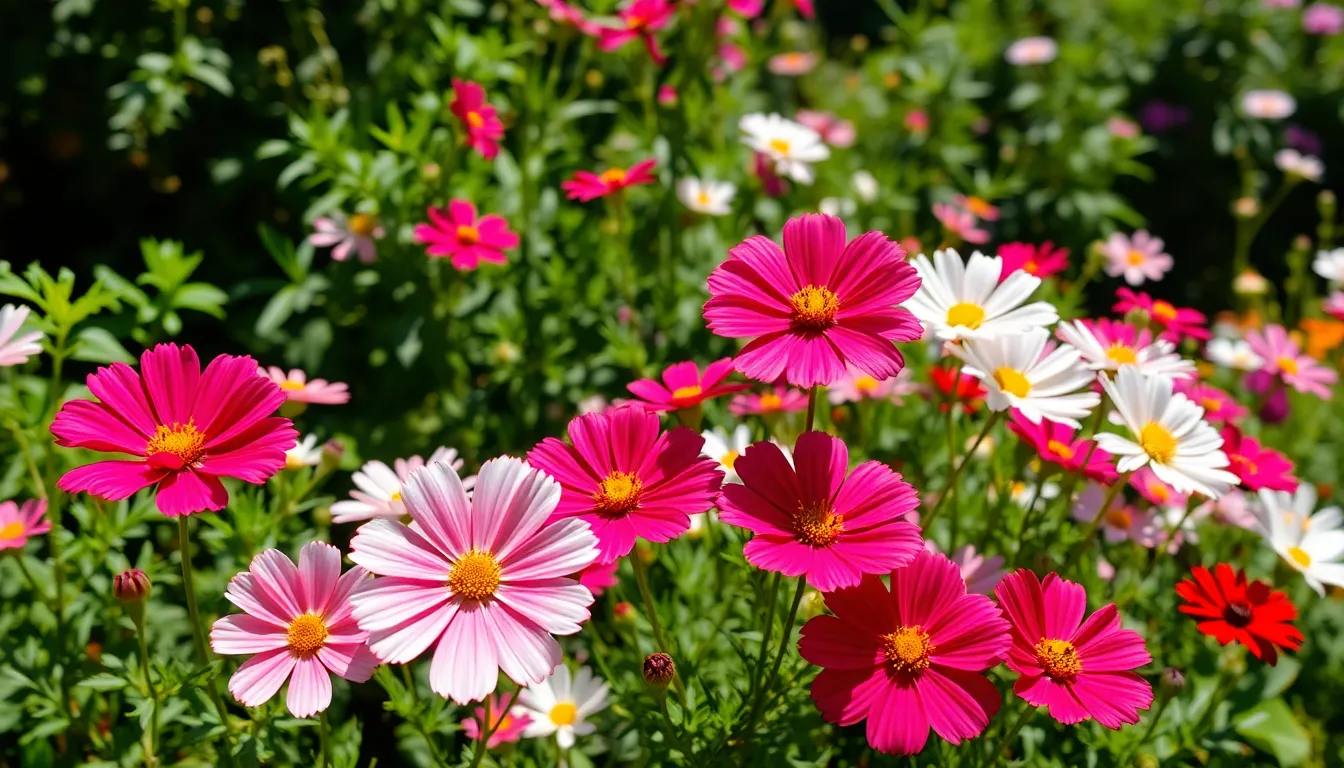
Cosmos deliver ethereal beauty with remarkable endurance throughout the summer months. These papery petaled flowers sway gracefully in garden breezes while maintaining their blooming vigor from early summer until frost.
Sensation Mix for Classic Cottage Garden Look
Sensation Mix cosmos create the quintessential cottage garden atmosphere with their delicate 4-inch blooms dancing atop feathery foliage. We love how these varieties reach 3-4 feet tall, creating perfect background plantings that add vertical interest without overwhelming smaller flowers. Pink, white, and crimson flowers appear continuously throughout the growing season, requiring minimal deadheading to maintain their prolific display.
These cosmos thrive in poor to average soil conditions, actually producing more flowers when nutrients aren’t overly abundant. We recommend spacing plants 12-18 inches apart to allow for their natural spreading habit while preventing overcrowding. Direct seeding in late spring produces the strongest plants, though you can start them indoors 4-6 weeks before the last frost date.
Sensation Mix varieties excel in cutting gardens, providing armloads of graceful stems for indoor arrangements. Their long vase life of 7-10 days makes them valuable additions to summer bouquets, while their self-seeding nature ensures returns in subsequent growing seasons.
Sulphur Cosmos for Unique Yellow and Orange Tones
Sulphur cosmos offer distinctive golden yellow and burnt orange blooms that differentiate them from traditional pink and white varieties. We find these heat loving plants particularly valuable for adding warm tones to summer color schemes, especially when paired with complementary blue or purple flowers. Their smaller 2-inch blooms appear in greater abundance than larger flowered types, creating dense displays of color.
These compact varieties typically reach 2-3 feet in height, making them suitable for middle border positions or container plantings. We appreciate their drought tolerance once established, though consistent moisture during establishment promotes faster growth and earlier flowering. Sulphur cosmos prefer full sun exposure but tolerate light afternoon shade in extremely hot climates.
Their unique coloration makes sulphur cosmos excellent companions for ornamental grasses, purple salvias, and deep blue ageratums. We often use them in naturalistic plantings where their informal growth habit complements wildflower meadow designs while providing reliable color from midsummer through fall.
Vinca: Drought-Tolerant Blooms for Harsh Conditions
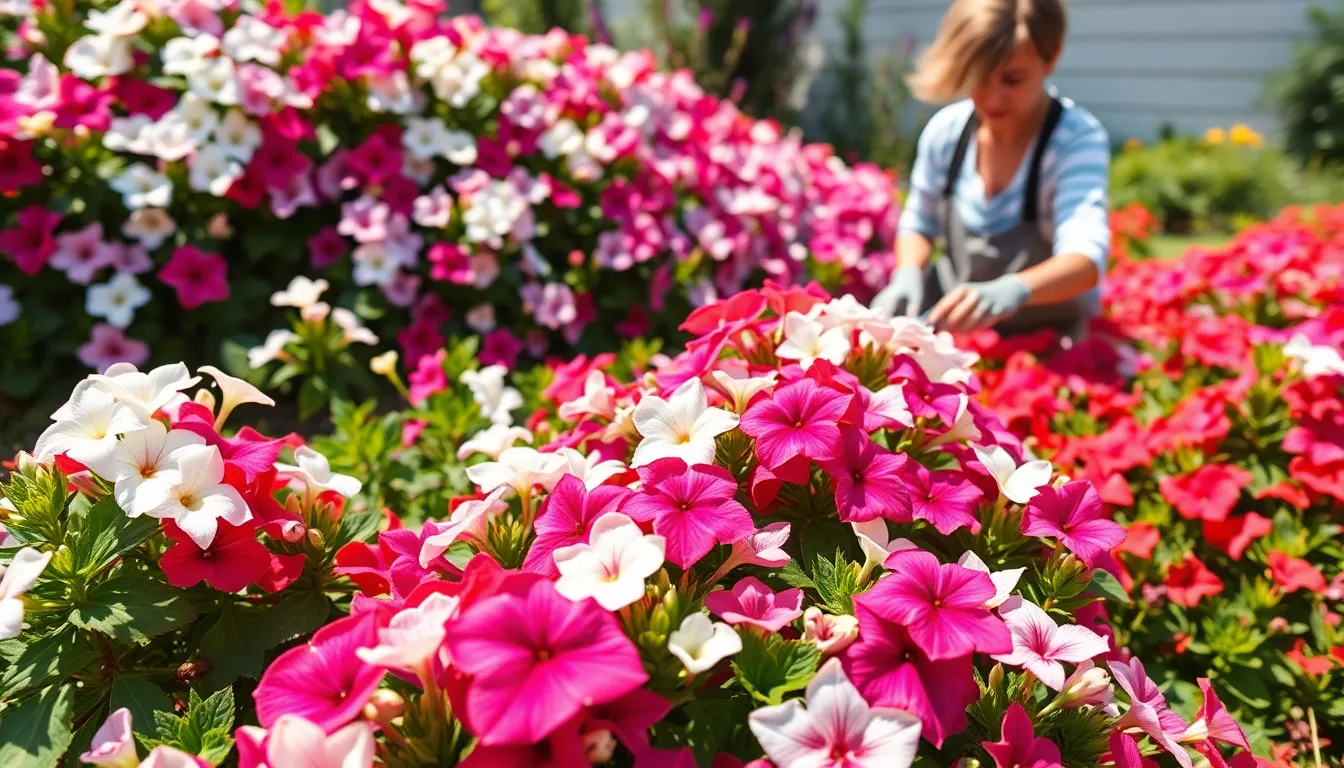
Vinca stands out as one of the most resilient summer annuals, thriving in conditions where other flowers struggle. This remarkable plant delivers consistent blooms throughout the hottest months while requiring minimal water and care.
Madagascar Periwinkle for Hot Climate Gardens
Madagascar periwinkle excels in challenging garden conditions that would stress most other annuals. Heat waves and drought conditions don’t phase this tough performer, making it our top choice for low-maintenance summer color. Gardeners in hot, arid climates find vinca particularly valuable because it maintains its vibrant appearance even when temperatures soar above 90°F.
Water restrictions become less of a concern when you plant vinca in your garden beds. These drought-tolerant flowers establish quickly and then survive on minimal irrigation, often thriving with just weekly watering once their root systems develop. Poor soil conditions actually benefit vinca growth, as rich, moisture-retentive soils can lead to root rot problems.
Container gardening becomes easier with vinca’s forgiving nature. Hanging baskets and patio planters filled with these resilient blooms require less frequent watering than those planted with more demanding annuals. Full sun exposure brings out the best flowering performance, though vinca tolerates partial shade in extremely hot climates.
Color options include classic white, bright pink, deep purple, and coral shades that maintain their intensity throughout the summer months. Modern varieties like the Cora series offer improved heat tolerance and larger flower sizes, while traditional cultivars provide reliable performance year after year.
Catharanthus Roseus for Medicinal and Ornamental Value
Catharanthus roseus serves dual purposes in our gardens, offering both ornamental beauty and historical medicinal significance. This scientific name refers to the same plant we commonly call vinca or Madagascar periwinkle, highlighting its importance beyond simple garden decoration. Traditional medicine has long recognized this plant’s therapeutic compounds, though we recommend consulting healthcare professionals before considering any medicinal uses.
Ornamental landscaping benefits tremendously from catharanthus roseus’s consistent blooming habit. Blue-purple flower varieties create stunning color combinations when paired with yellow marigolds or white sweet alyssum. Pink and white cultivars blend seamlessly with other pastel summer annuals, while deeper purple selections provide dramatic contrast in mixed plantings.
Professional landscapers frequently specify vinca for commercial installations because of its reliability and low maintenance requirements. Shopping centers, office complexes, and public gardens often feature mass plantings of catharanthus roseus for season-long color without intensive care. Disease resistance sets this plant apart from many other summer annuals that suffer from fungal problems in humid conditions.
Propagation occurs easily through both seeds and cuttings, making vinca an economical choice for large-scale plantings. Seeds germinate reliably in warm soil, while stem cuttings root quickly in water or moist potting mix. This versatility allows gardeners to expand their vinca displays without important additional investment.
Care Tips for Maintaining Continuous Summer Blooms
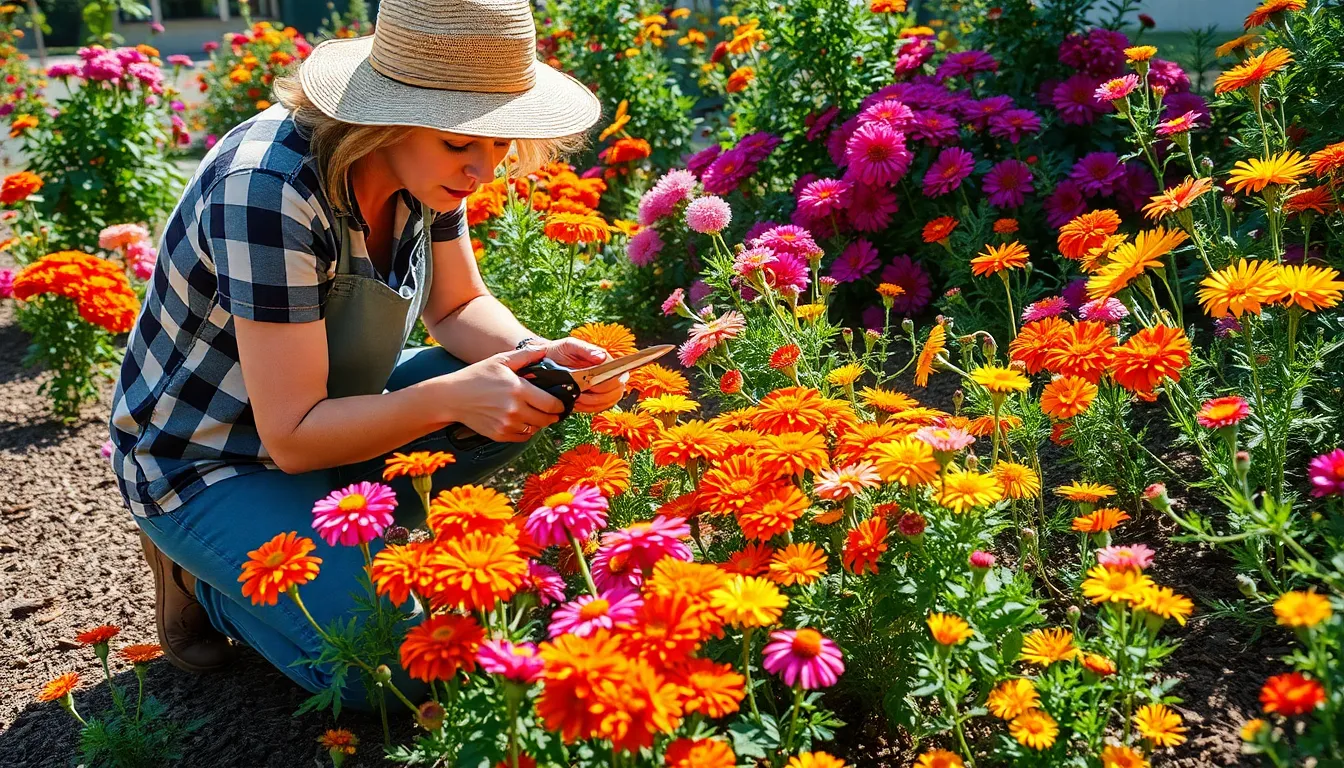
Proper maintenance transforms good summer annuals into spectacular displays that flourish from planting until frost. We’ll share the essential techniques that keep your flowers producing fresh blooms throughout the entire growing season.
Deadheading Techniques for Extended Flowering
Deadheading encourages prolific blooming by redirecting the plant’s energy from seed production back into flower development. We recommend checking your cosmos and floss flower weekly, pinching off spent blooms just above the next set of leaves or buds. Regular removal of faded flowers can double your bloom production in varieties like marigolds and zinnias.
Timing matters significantly when deadheading different annual varieties. We’ve found that morning deadheading works best when stems are fully hydrated and less likely to break. Cosmos responds particularly well to this technique, producing continuous waves of daisy-like flowers when maintained properly.
Snapdragons require minimal intervention since they continue blooming without deadheading, making them perfect for low-maintenance gardens. We simply allow these self-cleaning varieties to drop their spent flowers naturally while focusing our deadheading efforts on higher-maintenance species.
Pinching versus cutting depends on your flower type and stem strength. We use our fingers to pinch soft-stemmed annuals like impatiens and begonias, while employing clean scissors or pruning shears for tougher stems like sunflowers and celosia.
Watering and Fertilizing Schedules
Consistent moisture levels prevent stress-induced flowering interruptions that can halt bloom production for weeks. We water our summer annuals early morning to minimize evaporation and reduce disease risk, ensuring soil stays evenly moist but never waterlogged.
Overwatering kills more annuals than drought stress, particularly in poorly draining soils where root rot develops quickly. We test soil moisture by inserting our finger 2 inches deep, watering only when the top layer feels dry to the touch.
Monthly fertilizing with balanced nutrition supports continuous flower production throughout the growing season. We apply a 10-10-10 fertilizer once every four weeks, following package directions to avoid burning tender roots with excessive nutrients.
Container plants need more frequent feeding since frequent watering leaches nutrients from potting soil faster than garden beds. We fertilize our hanging baskets and containers every two weeks with half-strength liquid fertilizer to maintain optimal growth and flowering.
Mulching conserves moisture and reduces watering frequency while suppressing weeds that compete for nutrients. We apply 2-3 inches of organic mulch around our annuals, keeping it pulled back from plant stems to prevent fungal issues.
Conclusion
Creating a vibrant summer garden doesn’t have to be complicated when you choose the right annual flowers. We’ve shared our favorite varieties that’ll keep your garden colorful from spring through fall with minimal effort on your part.
From drought-tolerant marigolds to shade-loving impatiens these reliable bloomers offer something for every garden condition. Whether you’re working with containers full sun or challenging shady spots there’s an annual that’ll thrive in your space.
The key to success lies in selecting varieties that match your growing conditions and following simple maintenance routines. With proper deadheading watering and occasional fertilizing you’ll enjoy months of continuous blooms that’ll make your neighbors envious.
Frequently Asked Questions
What are the best long-blooming annuals for continuous summer color?
The top choices include marigolds, petunias, zinnias, impatiens, begonias, celosia, sunflowers, cosmos, and vinca. These flowers bloom consistently from spring through the first frost, providing vibrant color throughout the growing season. Each variety offers unique characteristics, from marigolds’ pest-deterring properties to petunias’ heat tolerance and impatiens’ shade adaptability.
How often should I deadhead my summer annuals to maintain blooms?
Most summer annuals benefit from weekly deadheading to encourage continuous blooming. Check plants like cosmos, zinnias, and petunias regularly for spent blooms. Morning is the ideal time for deadheading. However, some varieties like Wave petunias and Profusion Series zinnias are self-cleaning and require minimal intervention.
Which annuals work best in shaded areas of my garden?
Impatiens and begonias are excellent choices for shade. Standard impatiens thrive in deep shade, while New Guinea impatiens tolerate 4-6 hours of indirect sunlight. Wax begonias and Dragon Wing begonias also perform well in partial shade conditions, producing continuous blooms with minimal maintenance requirements.
How do I choose between French and African marigolds?
French marigolds are compact (6-12 inches) with numerous small blooms, perfect for containers and borders. African marigolds grow larger (12-36 inches) with bold, statement flowers ideal as focal points. French varieties work well for succession planting, while African types create dramatic displays in back borders or cutting gardens.
What’s the difference between Wave and Grandiflora petunias?
Wave petunias spread quickly as ground cover, requiring minimal deadheading and offering excellent heat tolerance. Grandiflora petunias feature large, showy flowers up to 5 inches across, perfect for containers and formal arrangements. Both types provide continuous color but serve different garden design purposes.
How can I prevent fungal issues in my zinnias?
Plant zinnias in full sun with proper spacing to ensure good air circulation. Choose disease-resistant varieties like the Profusion Series when possible. Water at soil level rather than overhead watering, and avoid overcrowding plants. Mulching around plants helps maintain consistent soil moisture while preventing soil-borne diseases.
Which summer annuals require the least maintenance?
Vinca (Madagascar periwinkle) tops the list for low maintenance, thriving in harsh conditions with minimal water. Cosmos, Wave petunias, and Profusion Series zinnias also require little care once established. These varieties are drought-tolerant, self-cleaning, and continue blooming without frequent intervention, making them perfect for busy gardeners.
How should I water and fertilize my summer annuals?
Water early morning at soil level to reduce evaporation and prevent fungal issues. Maintain consistent moisture without overwatering. Apply balanced fertilizer monthly during the growing season. Use organic mulch to conserve moisture and suppress weeds. Avoid over-fertilizing, which can reduce blooming and increase foliage growth.

